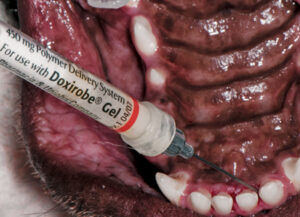
22 Oct When to Use Chlorhexidine Rinse/Gel and Doxirobe 7.5% Gel
For those of you that did not read my latest constant contact blog, I posed two questions regarding the usage of both Chlorhexdine 0.12% rinse/gel and Doxirobe 7.5% gel.
What Is Chlorhexidine Rinse/Gel?
Chlorhexidine rinse or gel is an excellent antiseptic agent that is used routinely in my dental procedures, and is a very good plaque-preventive product. Specific dental concentrations are 0.12-0.2%. It is NOT recommended to use the higher concentration typically used as a surgical prep/flush as it is 2% and is not fabricated to be used as an oral rinse. Therefore, don’t be cheap and try to dilute it.
Chlorhexidine should be rinsed in the mouth prior to scaling each quadrant, as this helps prevent the aerosolization of bacteria to the staff member performing the scaling procedure. It is used to rinse the gingival sulcus after scaling and closed root planing but IS NOT recommended for usage in periodontal pockets > 5 mm or to rinse an extraction site. You can use it to rinse the oral surgical line afterwards, when the tissue is closed. It can cause some staining of teeth when used chronically, but this staining is easily removed when teeth are brushed.
CET oral hygiene rinse is temporarily or possibly permanently off the market, and I use Oral Protection Gel from Dentaire and Dentahex rinse.
What Is Doxirobe Gel?
Doxirobe (Doxycycline 7.5%) gel is a valuable product that I use routinely with Stage 2 periodontal disease. It is used in periodontal pockets >3 mm and </= 5 mm deep. It is NOT intended for deeper pockets (>5 mm) as these require open root planing and either guided tissue regeneration and/or bone grafting.
Doxycycline is antibacterial, anti-prostaglandin, and anti-collagenase, and prevents MMP (matrix metalloprotease) formation. MMPs stimulate inflammatory cells which lead to osteoclastic activity. When used properly, Doxirobe can aid in decreasing a periodontal pocket from 5 mm to 2-3 mm in a couple of months.
HOWEVER, prior to placement of this material, closed root planing and subgingival curettage MUST be performed.
Board-Certified Veterinary Dentist in Nashville, Tennessee
If you don’t know how to do those two procedures, stay away from using Doxirobe and have your pet owner schedule an appointment with us.
Barden Greenfield, DVM, Dipl. AVDC – Diplomate of the American Veterinary Dental College (AVDC)
Your Pet Dentist of Nashville
ANSWERS: Chlorhexidine question (A); Doxirobe question (B)
Images used under creative commons license – commercial use (12/20/2023). Photo by Leohoho on Unsplash




